Impact of Domestic Violence and Divorce on Child Mental Health
VerifiedAdded on 2022/12/27
|24
|6678
|373
Report
AI Summary
This research proposal presents a systematic review investigating the impact of domestic violence and parental divorce on children's mental health in the United Kingdom. The study aims to analyze the short-term and long-term psychological effects of these situations on children, considering the high rates of domestic violence and divorce within the UK. The methodology involves a systematic review of articles from databases such as PubMed and BMJ, incorporating both qualitative (interviews, focus groups) and quantitative (offline surveys) research methods. The research seeks to identify the implications for parents, schools, counseling systems, and the government, with the goal of increasing awareness and implementing more effective support systems for affected children. The proposal acknowledges limitations such as the exclusion of certain data and age groups, while also highlighting the potential for future research and dissemination of findings through various public health channels. The research questions focus on the impact of domestic violence and parental divorce on children's mental well-being, aiming to identify the short-term and long-term implications and to provide recommendations for improving the mental health of children facing family disturbances. The study's design includes systematic review to analyze the articles, and the research will be specified to articles dealing with child counseling along with excluding article from non-medical sources. The research methodology is the technique that as the pillar of the total research, it justified how the study will be executed, how data will be collected, they are going to be measured, and which process the conclusion will be calculated.
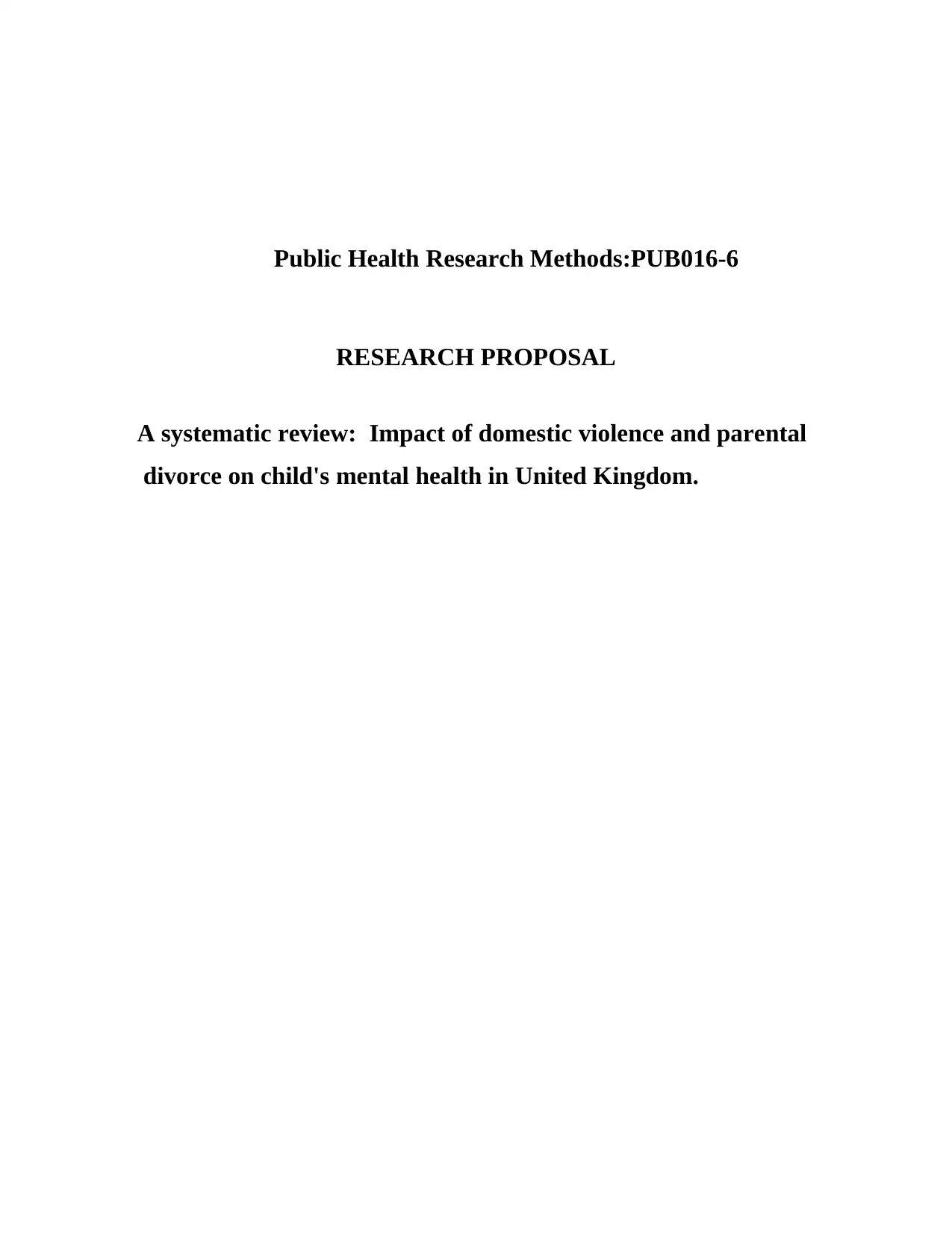
Public Health Research Methods:PUB016-6
RESEARCH PROPOSAL
A systematic review: Impact of domestic violence and parental
divorce on child's mental health in United Kingdom.
RESEARCH PROPOSAL
A systematic review: Impact of domestic violence and parental
divorce on child's mental health in United Kingdom.
Paraphrase This Document
Need a fresh take? Get an instant paraphrase of this document with our AI Paraphraser
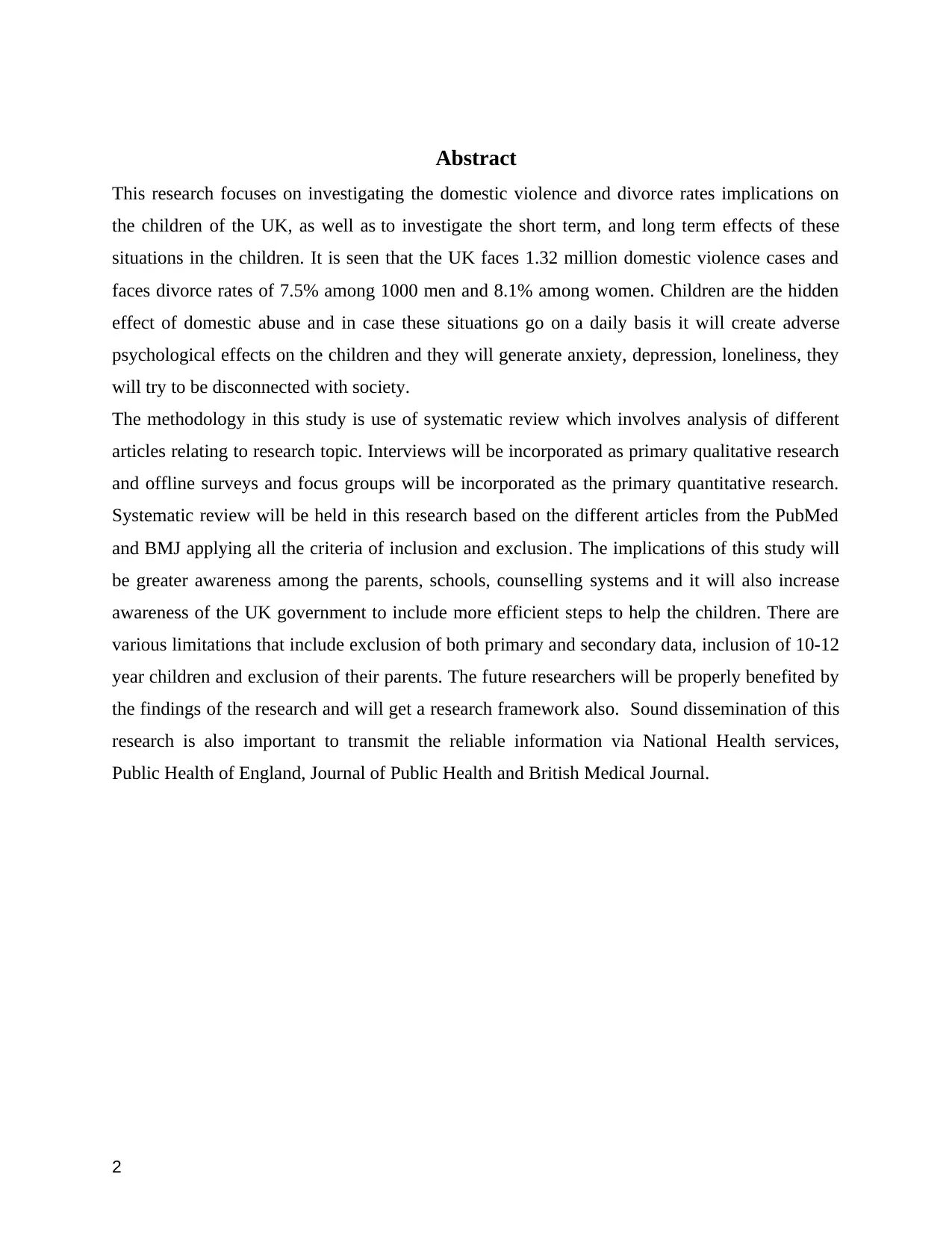
Abstract
This research focuses on investigating the domestic violence and divorce rates implications on
the children of the UK, as well as to investigate the short term, and long term effects of these
situations in the children. It is seen that the UK faces 1.32 million domestic violence cases and
faces divorce rates of 7.5% among 1000 men and 8.1% among women. Children are the hidden
effect of domestic abuse and in case these situations go on a daily basis it will create adverse
psychological effects on the children and they will generate anxiety, depression, loneliness, they
will try to be disconnected with society.
The methodology in this study is use of systematic review which involves analysis of different
articles relating to research topic. Interviews will be incorporated as primary qualitative research
and offline surveys and focus groups will be incorporated as the primary quantitative research.
Systematic review will be held in this research based on the different articles from the PubMed
and BMJ applying all the criteria of inclusion and exclusion. The implications of this study will
be greater awareness among the parents, schools, counselling systems and it will also increase
awareness of the UK government to include more efficient steps to help the children. There are
various limitations that include exclusion of both primary and secondary data, inclusion of 10-12
year children and exclusion of their parents. The future researchers will be properly benefited by
the findings of the research and will get a research framework also. Sound dissemination of this
research is also important to transmit the reliable information via National Health services,
Public Health of England, Journal of Public Health and British Medical Journal.
2
This research focuses on investigating the domestic violence and divorce rates implications on
the children of the UK, as well as to investigate the short term, and long term effects of these
situations in the children. It is seen that the UK faces 1.32 million domestic violence cases and
faces divorce rates of 7.5% among 1000 men and 8.1% among women. Children are the hidden
effect of domestic abuse and in case these situations go on a daily basis it will create adverse
psychological effects on the children and they will generate anxiety, depression, loneliness, they
will try to be disconnected with society.
The methodology in this study is use of systematic review which involves analysis of different
articles relating to research topic. Interviews will be incorporated as primary qualitative research
and offline surveys and focus groups will be incorporated as the primary quantitative research.
Systematic review will be held in this research based on the different articles from the PubMed
and BMJ applying all the criteria of inclusion and exclusion. The implications of this study will
be greater awareness among the parents, schools, counselling systems and it will also increase
awareness of the UK government to include more efficient steps to help the children. There are
various limitations that include exclusion of both primary and secondary data, inclusion of 10-12
year children and exclusion of their parents. The future researchers will be properly benefited by
the findings of the research and will get a research framework also. Sound dissemination of this
research is also important to transmit the reliable information via National Health services,
Public Health of England, Journal of Public Health and British Medical Journal.
2
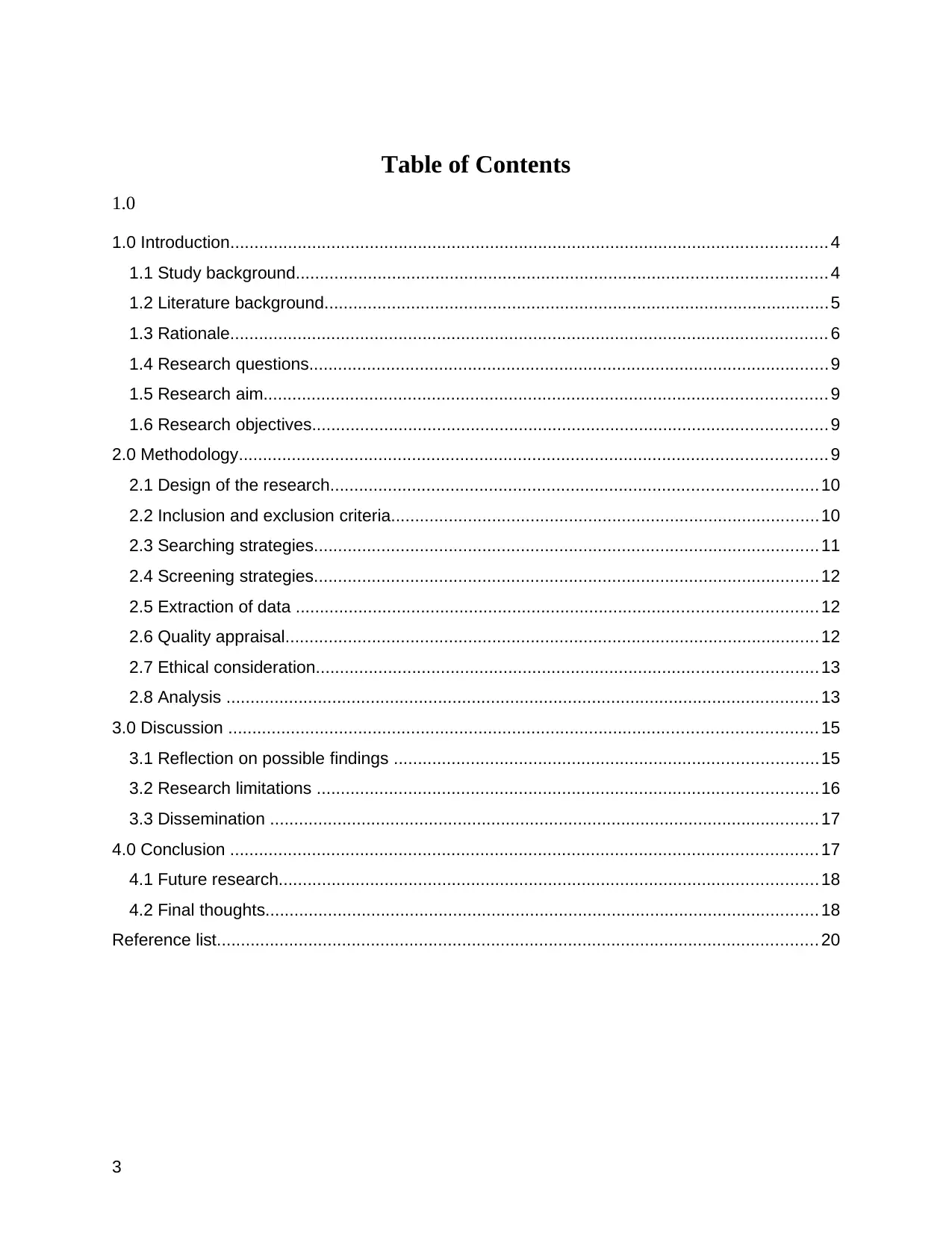
Table of Contents
1.0
1.0 Introduction............................................................................................................................ 4
1.1 Study background.............................................................................................................. 4
1.2 Literature background.........................................................................................................5
1.3 Rationale............................................................................................................................ 6
1.4 Research questions............................................................................................................9
1.5 Research aim..................................................................................................................... 9
1.6 Research objectives........................................................................................................... 9
2.0 Methodology.......................................................................................................................... 9
2.1 Design of the research.....................................................................................................10
2.2 Inclusion and exclusion criteria.........................................................................................10
2.3 Searching strategies.........................................................................................................11
2.4 Screening strategies.........................................................................................................12
2.5 Extraction of data ............................................................................................................ 12
2.6 Quality appraisal............................................................................................................... 12
2.7 Ethical consideration........................................................................................................13
2.8 Analysis ........................................................................................................................... 13
3.0 Discussion .......................................................................................................................... 15
3.1 Reflection on possible findings ........................................................................................15
3.2 Research limitations ........................................................................................................16
3.3 Dissemination .................................................................................................................. 17
4.0 Conclusion .......................................................................................................................... 17
4.1 Future research................................................................................................................ 18
4.2 Final thoughts................................................................................................................... 18
Reference list............................................................................................................................. 20
3
1.0
1.0 Introduction............................................................................................................................ 4
1.1 Study background.............................................................................................................. 4
1.2 Literature background.........................................................................................................5
1.3 Rationale............................................................................................................................ 6
1.4 Research questions............................................................................................................9
1.5 Research aim..................................................................................................................... 9
1.6 Research objectives........................................................................................................... 9
2.0 Methodology.......................................................................................................................... 9
2.1 Design of the research.....................................................................................................10
2.2 Inclusion and exclusion criteria.........................................................................................10
2.3 Searching strategies.........................................................................................................11
2.4 Screening strategies.........................................................................................................12
2.5 Extraction of data ............................................................................................................ 12
2.6 Quality appraisal............................................................................................................... 12
2.7 Ethical consideration........................................................................................................13
2.8 Analysis ........................................................................................................................... 13
3.0 Discussion .......................................................................................................................... 15
3.1 Reflection on possible findings ........................................................................................15
3.2 Research limitations ........................................................................................................16
3.3 Dissemination .................................................................................................................. 17
4.0 Conclusion .......................................................................................................................... 17
4.1 Future research................................................................................................................ 18
4.2 Final thoughts................................................................................................................... 18
Reference list............................................................................................................................. 20
3
⊘ This is a preview!⊘
Do you want full access?
Subscribe today to unlock all pages.

Trusted by 1+ million students worldwide
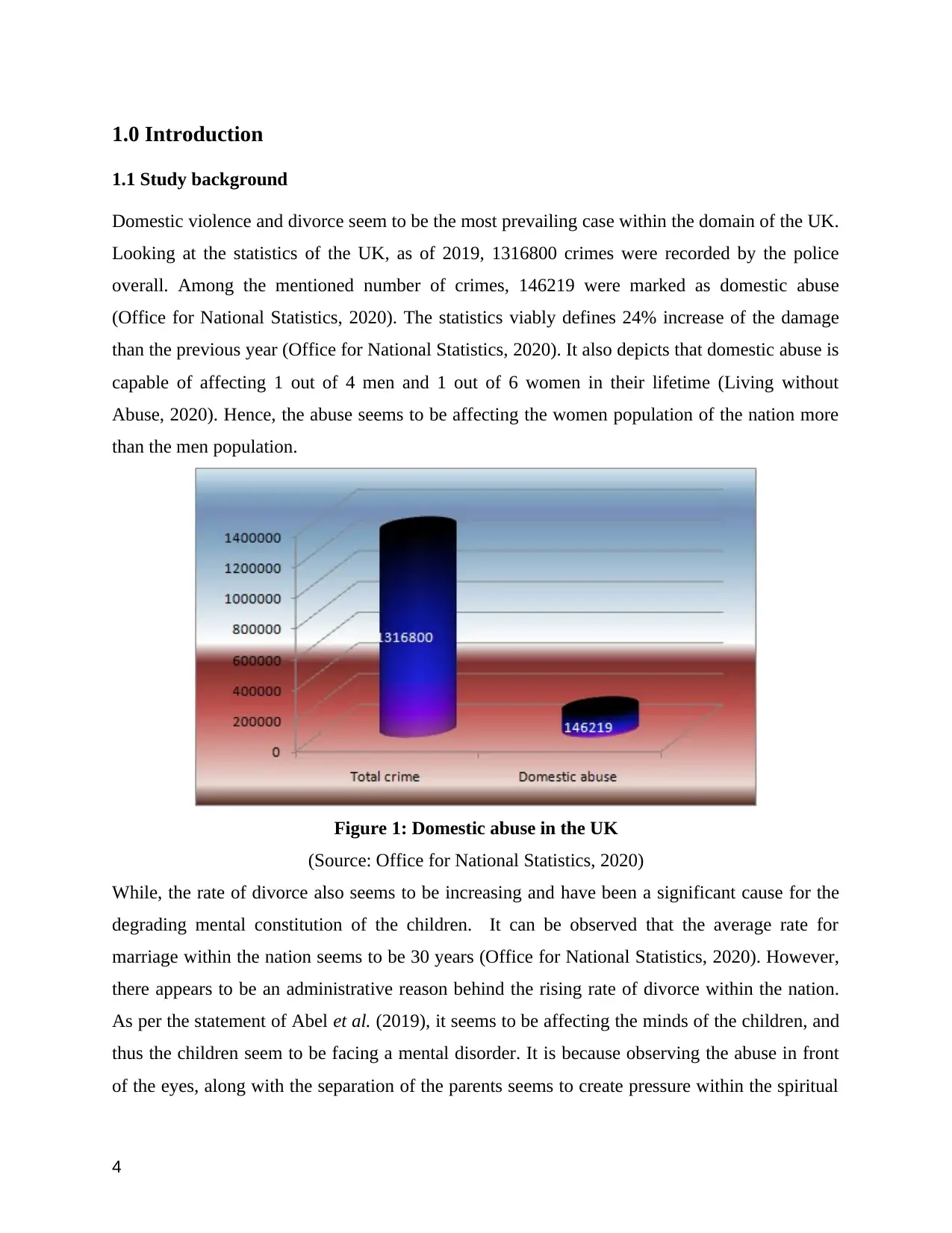
1.0 Introduction
1.1 Study background
Domestic violence and divorce seem to be the most prevailing case within the domain of the UK.
Looking at the statistics of the UK, as of 2019, 1316800 crimes were recorded by the police
overall. Among the mentioned number of crimes, 146219 were marked as domestic abuse
(Office for National Statistics, 2020). The statistics viably defines 24% increase of the damage
than the previous year (Office for National Statistics, 2020). It also depicts that domestic abuse is
capable of affecting 1 out of 4 men and 1 out of 6 women in their lifetime (Living without
Abuse, 2020). Hence, the abuse seems to be affecting the women population of the nation more
than the men population.
Figure 1: Domestic abuse in the UK
(Source: Office for National Statistics, 2020)
While, the rate of divorce also seems to be increasing and have been a significant cause for the
degrading mental constitution of the children. It can be observed that the average rate for
marriage within the nation seems to be 30 years (Office for National Statistics, 2020). However,
there appears to be an administrative reason behind the rising rate of divorce within the nation.
As per the statement of Abel et al. (2019), it seems to be affecting the minds of the children, and
thus the children seem to be facing a mental disorder. It is because observing the abuse in front
of the eyes, along with the separation of the parents seems to create pressure within the spiritual
4
1.1 Study background
Domestic violence and divorce seem to be the most prevailing case within the domain of the UK.
Looking at the statistics of the UK, as of 2019, 1316800 crimes were recorded by the police
overall. Among the mentioned number of crimes, 146219 were marked as domestic abuse
(Office for National Statistics, 2020). The statistics viably defines 24% increase of the damage
than the previous year (Office for National Statistics, 2020). It also depicts that domestic abuse is
capable of affecting 1 out of 4 men and 1 out of 6 women in their lifetime (Living without
Abuse, 2020). Hence, the abuse seems to be affecting the women population of the nation more
than the men population.
Figure 1: Domestic abuse in the UK
(Source: Office for National Statistics, 2020)
While, the rate of divorce also seems to be increasing and have been a significant cause for the
degrading mental constitution of the children. It can be observed that the average rate for
marriage within the nation seems to be 30 years (Office for National Statistics, 2020). However,
there appears to be an administrative reason behind the rising rate of divorce within the nation.
As per the statement of Abel et al. (2019), it seems to be affecting the minds of the children, and
thus the children seem to be facing a mental disorder. It is because observing the abuse in front
of the eyes, along with the separation of the parents seems to create pressure within the spiritual
4
Paraphrase This Document
Need a fresh take? Get an instant paraphrase of this document with our AI Paraphraser
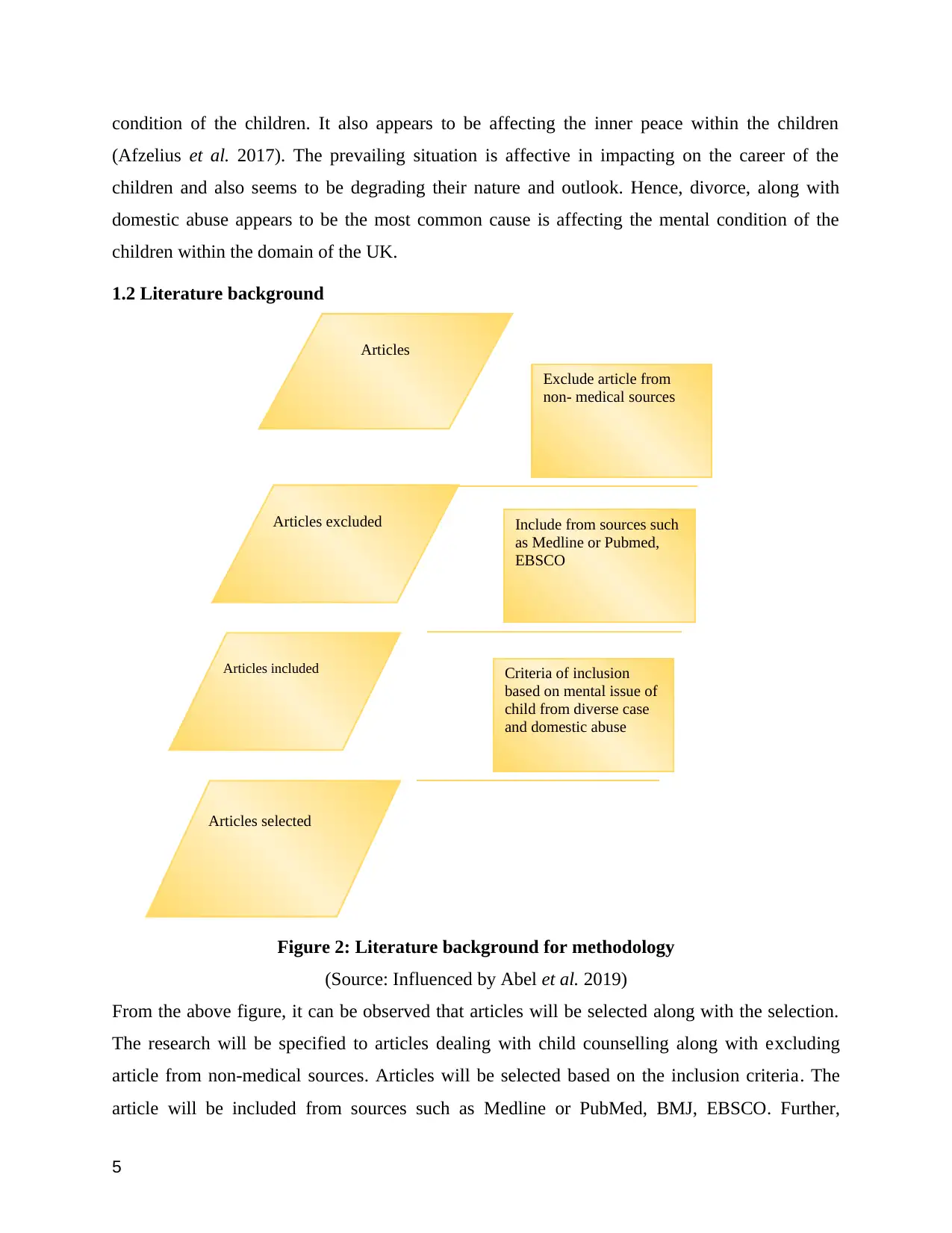
condition of the children. It also appears to be affecting the inner peace within the children
(Afzelius et al. 2017). The prevailing situation is affective in impacting on the career of the
children and also seems to be degrading their nature and outlook. Hence, divorce, along with
domestic abuse appears to be the most common cause is affecting the mental condition of the
children within the domain of the UK.
1.2 Literature background
Figure 2: Literature background for methodology
(Source: Influenced by Abel et al. 2019)
From the above figure, it can be observed that articles will be selected along with the selection.
The research will be specified to articles dealing with child counselling along with excluding
article from non-medical sources. Articles will be selected based on the inclusion criteria. The
article will be included from sources such as Medline or PubMed, BMJ, EBSCO. Further,
5
Articles
Articles excluded
Exclude article from
non- medical sources
Articles included
Include from sources such
as Medline or Pubmed,
EBSCO
Articles selected
Criteria of inclusion
based on mental issue of
child from diverse case
and domestic abuse
(Afzelius et al. 2017). The prevailing situation is affective in impacting on the career of the
children and also seems to be degrading their nature and outlook. Hence, divorce, along with
domestic abuse appears to be the most common cause is affecting the mental condition of the
children within the domain of the UK.
1.2 Literature background
Figure 2: Literature background for methodology
(Source: Influenced by Abel et al. 2019)
From the above figure, it can be observed that articles will be selected along with the selection.
The research will be specified to articles dealing with child counselling along with excluding
article from non-medical sources. Articles will be selected based on the inclusion criteria. The
article will be included from sources such as Medline or PubMed, BMJ, EBSCO. Further,
5
Articles
Articles excluded
Exclude article from
non- medical sources
Articles included
Include from sources such
as Medline or Pubmed,
EBSCO
Articles selected
Criteria of inclusion
based on mental issue of
child from diverse case
and domestic abuse
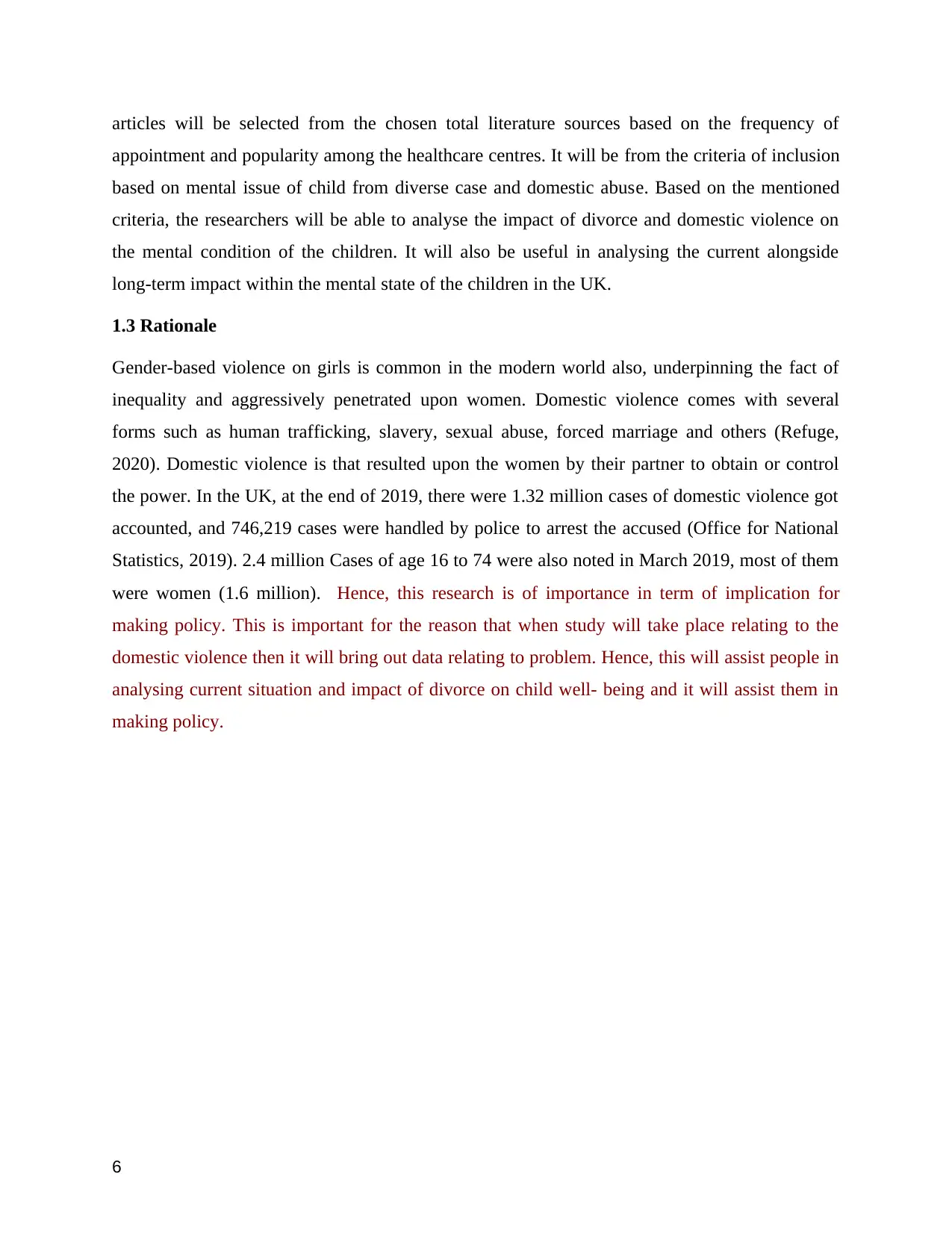
articles will be selected from the chosen total literature sources based on the frequency of
appointment and popularity among the healthcare centres. It will be from the criteria of inclusion
based on mental issue of child from diverse case and domestic abuse. Based on the mentioned
criteria, the researchers will be able to analyse the impact of divorce and domestic violence on
the mental condition of the children. It will also be useful in analysing the current alongside
long-term impact within the mental state of the children in the UK.
1.3 Rationale
Gender-based violence on girls is common in the modern world also, underpinning the fact of
inequality and aggressively penetrated upon women. Domestic violence comes with several
forms such as human trafficking, slavery, sexual abuse, forced marriage and others (Refuge,
2020). Domestic violence is that resulted upon the women by their partner to obtain or control
the power. In the UK, at the end of 2019, there were 1.32 million cases of domestic violence got
accounted, and 746,219 cases were handled by police to arrest the accused (Office for National
Statistics, 2019). 2.4 million Cases of age 16 to 74 were also noted in March 2019, most of them
were women (1.6 million). Hence, this research is of importance in term of implication for
making policy. This is important for the reason that when study will take place relating to the
domestic violence then it will bring out data relating to problem. Hence, this will assist people in
analysing current situation and impact of divorce on child well- being and it will assist them in
making policy.
6
appointment and popularity among the healthcare centres. It will be from the criteria of inclusion
based on mental issue of child from diverse case and domestic abuse. Based on the mentioned
criteria, the researchers will be able to analyse the impact of divorce and domestic violence on
the mental condition of the children. It will also be useful in analysing the current alongside
long-term impact within the mental state of the children in the UK.
1.3 Rationale
Gender-based violence on girls is common in the modern world also, underpinning the fact of
inequality and aggressively penetrated upon women. Domestic violence comes with several
forms such as human trafficking, slavery, sexual abuse, forced marriage and others (Refuge,
2020). Domestic violence is that resulted upon the women by their partner to obtain or control
the power. In the UK, at the end of 2019, there were 1.32 million cases of domestic violence got
accounted, and 746,219 cases were handled by police to arrest the accused (Office for National
Statistics, 2019). 2.4 million Cases of age 16 to 74 were also noted in March 2019, most of them
were women (1.6 million). Hence, this research is of importance in term of implication for
making policy. This is important for the reason that when study will take place relating to the
domestic violence then it will bring out data relating to problem. Hence, this will assist people in
analysing current situation and impact of divorce on child well- being and it will assist them in
making policy.
6
⊘ This is a preview!⊘
Do you want full access?
Subscribe today to unlock all pages.

Trusted by 1+ million students worldwide
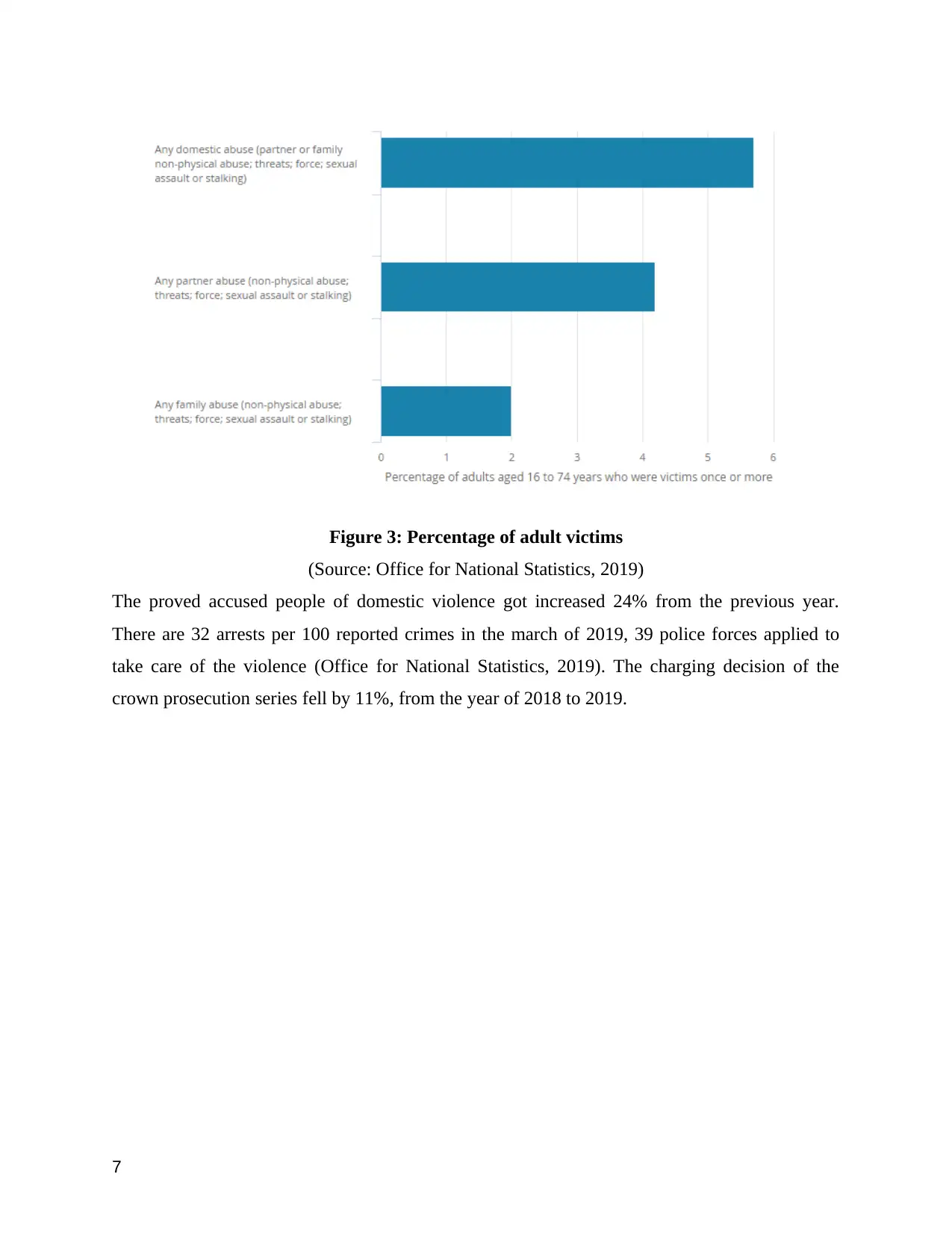
Figure 3: Percentage of adult victims
(Source: Office for National Statistics, 2019)
The proved accused people of domestic violence got increased 24% from the previous year.
There are 32 arrests per 100 reported crimes in the march of 2019, 39 police forces applied to
take care of the violence (Office for National Statistics, 2019). The charging decision of the
crown prosecution series fell by 11%, from the year of 2018 to 2019.
7
(Source: Office for National Statistics, 2019)
The proved accused people of domestic violence got increased 24% from the previous year.
There are 32 arrests per 100 reported crimes in the march of 2019, 39 police forces applied to
take care of the violence (Office for National Statistics, 2019). The charging decision of the
crown prosecution series fell by 11%, from the year of 2018 to 2019.
7
Paraphrase This Document
Need a fresh take? Get an instant paraphrase of this document with our AI Paraphraser
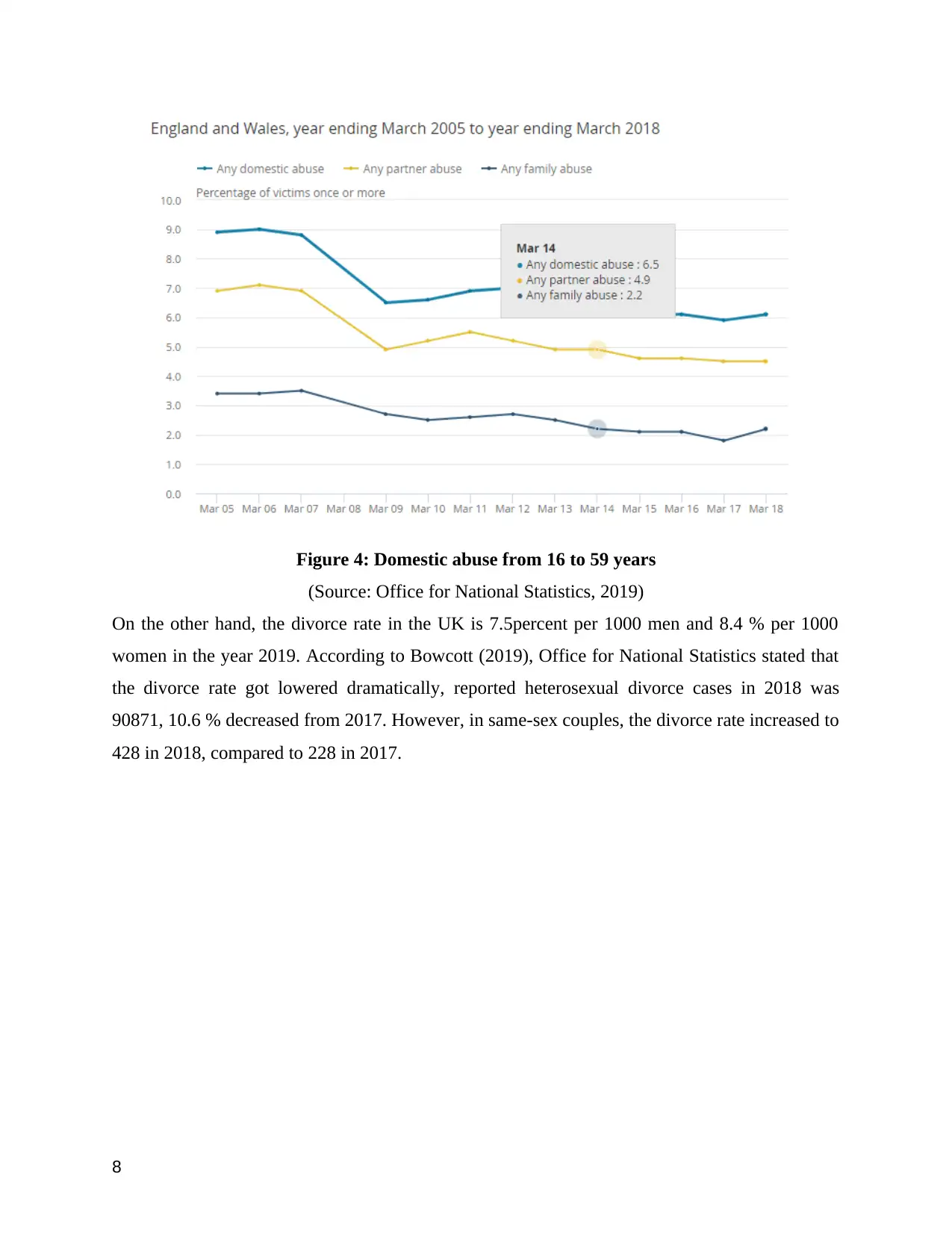
Figure 4: Domestic abuse from 16 to 59 years
(Source: Office for National Statistics, 2019)
On the other hand, the divorce rate in the UK is 7.5percent per 1000 men and 8.4 % per 1000
women in the year 2019. According to Bowcott (2019), Office for National Statistics stated that
the divorce rate got lowered dramatically, reported heterosexual divorce cases in 2018 was
90871, 10.6 % decreased from 2017. However, in same-sex couples, the divorce rate increased to
428 in 2018, compared to 228 in 2017.
8
(Source: Office for National Statistics, 2019)
On the other hand, the divorce rate in the UK is 7.5percent per 1000 men and 8.4 % per 1000
women in the year 2019. According to Bowcott (2019), Office for National Statistics stated that
the divorce rate got lowered dramatically, reported heterosexual divorce cases in 2018 was
90871, 10.6 % decreased from 2017. However, in same-sex couples, the divorce rate increased to
428 in 2018, compared to 228 in 2017.
8
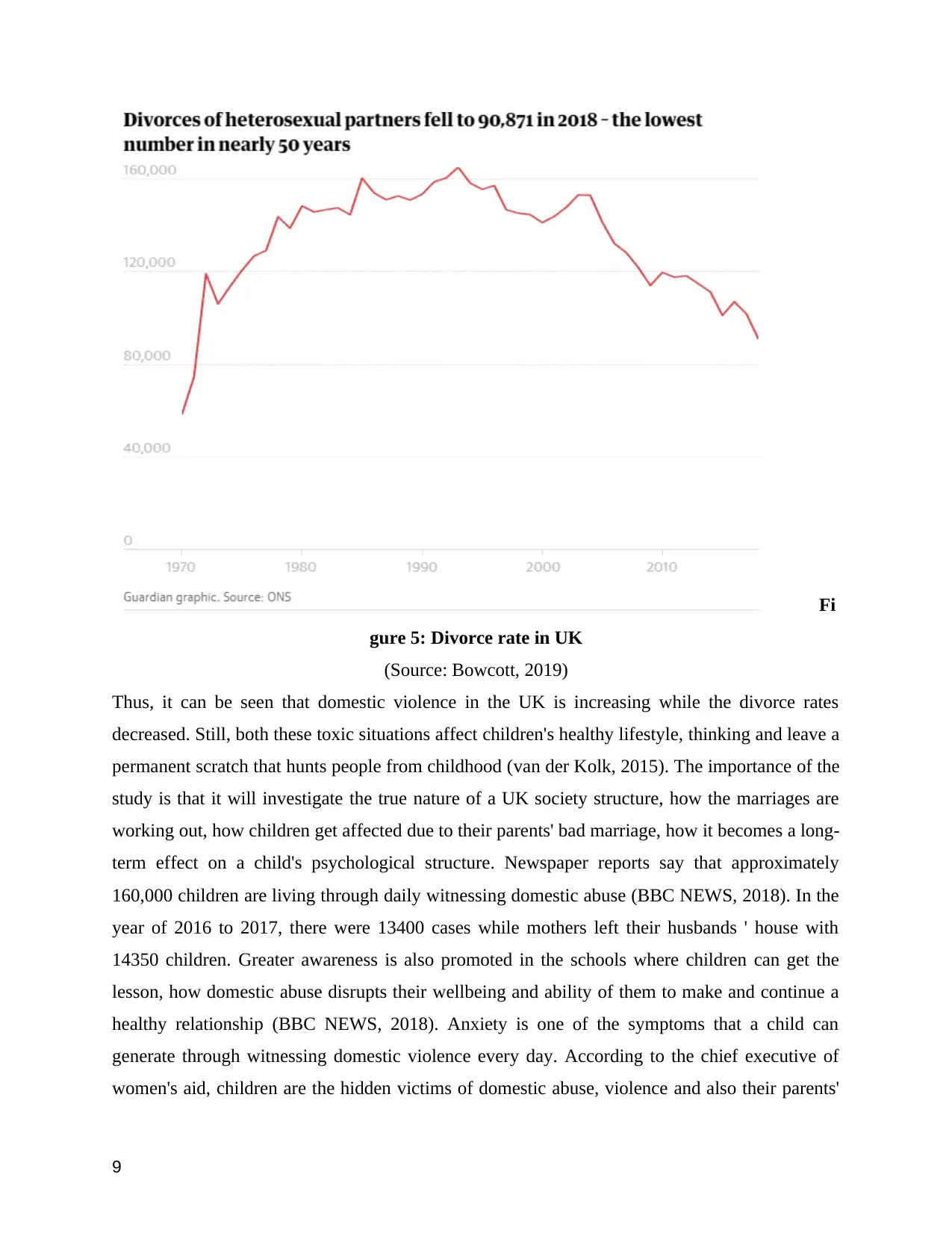
Fi
gure 5: Divorce rate in UK
(Source: Bowcott, 2019)
Thus, it can be seen that domestic violence in the UK is increasing while the divorce rates
decreased. Still, both these toxic situations affect children's healthy lifestyle, thinking and leave a
permanent scratch that hunts people from childhood (van der Kolk, 2015). The importance of the
study is that it will investigate the true nature of a UK society structure, how the marriages are
working out, how children get affected due to their parents' bad marriage, how it becomes a long-
term effect on a child's psychological structure. Newspaper reports say that approximately
160,000 children are living through daily witnessing domestic abuse (BBC NEWS, 2018). In the
year of 2016 to 2017, there were 13400 cases while mothers left their husbands ' house with
14350 children. Greater awareness is also promoted in the schools where children can get the
lesson, how domestic abuse disrupts their wellbeing and ability of them to make and continue a
healthy relationship (BBC NEWS, 2018). Anxiety is one of the symptoms that a child can
generate through witnessing domestic violence every day. According to the chief executive of
women's aid, children are the hidden victims of domestic abuse, violence and also their parents'
9
gure 5: Divorce rate in UK
(Source: Bowcott, 2019)
Thus, it can be seen that domestic violence in the UK is increasing while the divorce rates
decreased. Still, both these toxic situations affect children's healthy lifestyle, thinking and leave a
permanent scratch that hunts people from childhood (van der Kolk, 2015). The importance of the
study is that it will investigate the true nature of a UK society structure, how the marriages are
working out, how children get affected due to their parents' bad marriage, how it becomes a long-
term effect on a child's psychological structure. Newspaper reports say that approximately
160,000 children are living through daily witnessing domestic abuse (BBC NEWS, 2018). In the
year of 2016 to 2017, there were 13400 cases while mothers left their husbands ' house with
14350 children. Greater awareness is also promoted in the schools where children can get the
lesson, how domestic abuse disrupts their wellbeing and ability of them to make and continue a
healthy relationship (BBC NEWS, 2018). Anxiety is one of the symptoms that a child can
generate through witnessing domestic violence every day. According to the chief executive of
women's aid, children are the hidden victims of domestic abuse, violence and also their parents'
9
⊘ This is a preview!⊘
Do you want full access?
Subscribe today to unlock all pages.

Trusted by 1+ million students worldwide
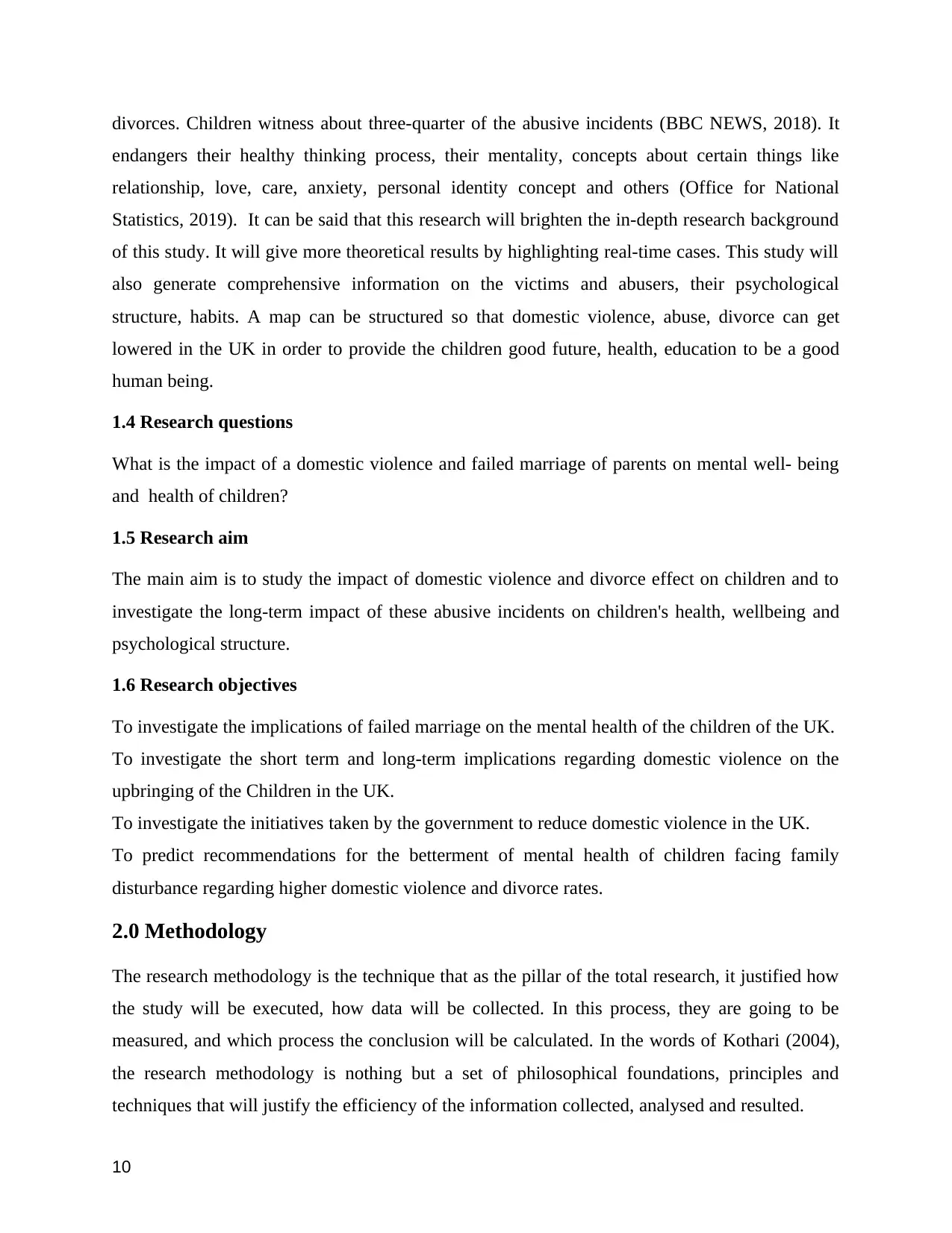
divorces. Children witness about three-quarter of the abusive incidents (BBC NEWS, 2018). It
endangers their healthy thinking process, their mentality, concepts about certain things like
relationship, love, care, anxiety, personal identity concept and others (Office for National
Statistics, 2019). It can be said that this research will brighten the in-depth research background
of this study. It will give more theoretical results by highlighting real-time cases. This study will
also generate comprehensive information on the victims and abusers, their psychological
structure, habits. A map can be structured so that domestic violence, abuse, divorce can get
lowered in the UK in order to provide the children good future, health, education to be a good
human being.
1.4 Research questions
What is the impact of a domestic violence and failed marriage of parents on mental well- being
and health of children?
1.5 Research aim
The main aim is to study the impact of domestic violence and divorce effect on children and to
investigate the long-term impact of these abusive incidents on children's health, wellbeing and
psychological structure.
1.6 Research objectives
To investigate the implications of failed marriage on the mental health of the children of the UK.
To investigate the short term and long-term implications regarding domestic violence on the
upbringing of the Children in the UK.
To investigate the initiatives taken by the government to reduce domestic violence in the UK.
To predict recommendations for the betterment of mental health of children facing family
disturbance regarding higher domestic violence and divorce rates.
2.0 Methodology
The research methodology is the technique that as the pillar of the total research, it justified how
the study will be executed, how data will be collected. In this process, they are going to be
measured, and which process the conclusion will be calculated. In the words of Kothari (2004),
the research methodology is nothing but a set of philosophical foundations, principles and
techniques that will justify the efficiency of the information collected, analysed and resulted.
10
endangers their healthy thinking process, their mentality, concepts about certain things like
relationship, love, care, anxiety, personal identity concept and others (Office for National
Statistics, 2019). It can be said that this research will brighten the in-depth research background
of this study. It will give more theoretical results by highlighting real-time cases. This study will
also generate comprehensive information on the victims and abusers, their psychological
structure, habits. A map can be structured so that domestic violence, abuse, divorce can get
lowered in the UK in order to provide the children good future, health, education to be a good
human being.
1.4 Research questions
What is the impact of a domestic violence and failed marriage of parents on mental well- being
and health of children?
1.5 Research aim
The main aim is to study the impact of domestic violence and divorce effect on children and to
investigate the long-term impact of these abusive incidents on children's health, wellbeing and
psychological structure.
1.6 Research objectives
To investigate the implications of failed marriage on the mental health of the children of the UK.
To investigate the short term and long-term implications regarding domestic violence on the
upbringing of the Children in the UK.
To investigate the initiatives taken by the government to reduce domestic violence in the UK.
To predict recommendations for the betterment of mental health of children facing family
disturbance regarding higher domestic violence and divorce rates.
2.0 Methodology
The research methodology is the technique that as the pillar of the total research, it justified how
the study will be executed, how data will be collected. In this process, they are going to be
measured, and which process the conclusion will be calculated. In the words of Kothari (2004),
the research methodology is nothing but a set of philosophical foundations, principles and
techniques that will justify the efficiency of the information collected, analysed and resulted.
10
Paraphrase This Document
Need a fresh take? Get an instant paraphrase of this document with our AI Paraphraser
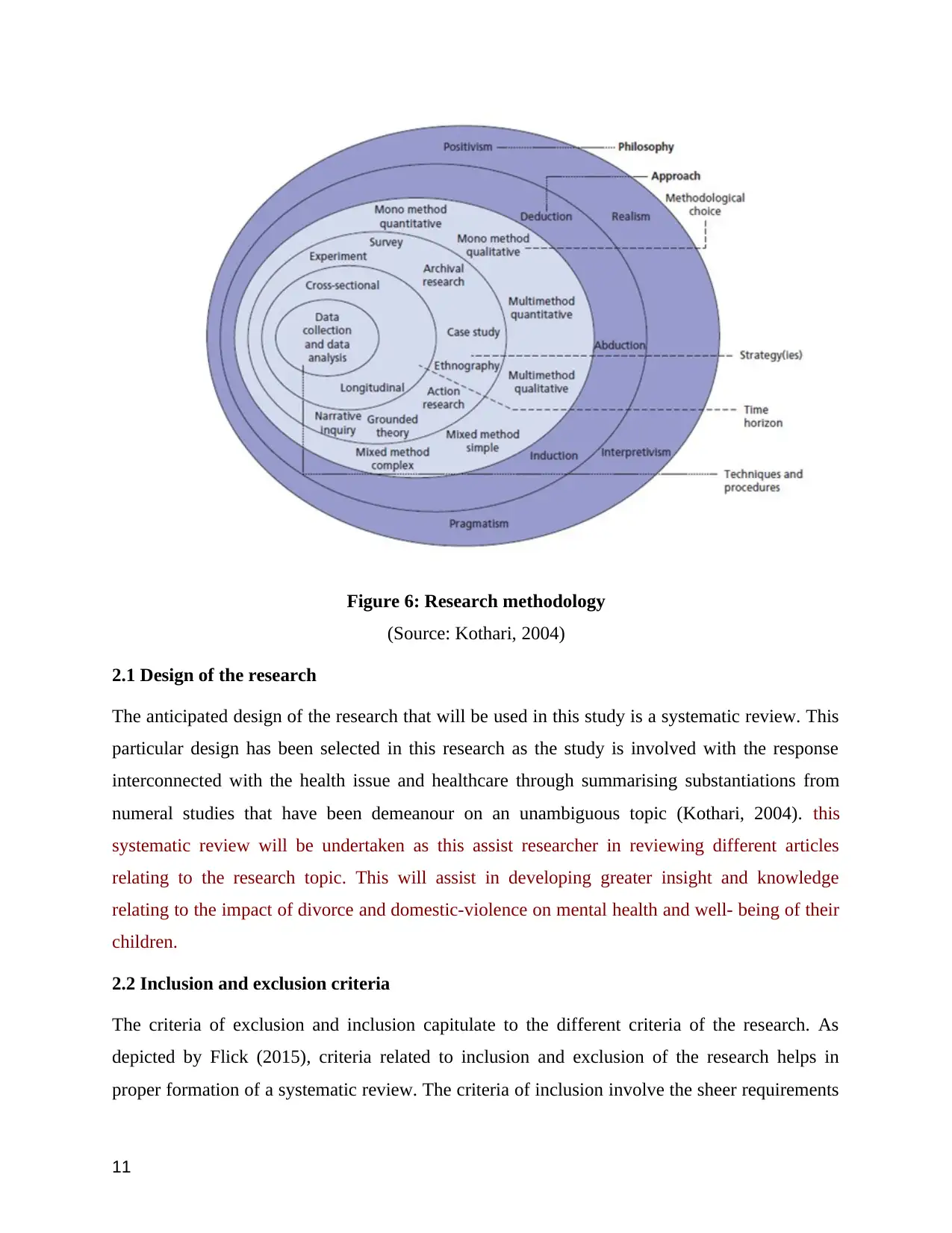
Figure 6: Research methodology
(Source: Kothari, 2004)
2.1 Design of the research
The anticipated design of the research that will be used in this study is a systematic review. This
particular design has been selected in this research as the study is involved with the response
interconnected with the health issue and healthcare through summarising substantiations from
numeral studies that have been demeanour on an unambiguous topic (Kothari, 2004). this
systematic review will be undertaken as this assist researcher in reviewing different articles
relating to the research topic. This will assist in developing greater insight and knowledge
relating to the impact of divorce and domestic-violence on mental health and well- being of their
children.
2.2 Inclusion and exclusion criteria
The criteria of exclusion and inclusion capitulate to the different criteria of the research. As
depicted by Flick (2015), criteria related to inclusion and exclusion of the research helps in
proper formation of a systematic review. The criteria of inclusion involve the sheer requirements
11
(Source: Kothari, 2004)
2.1 Design of the research
The anticipated design of the research that will be used in this study is a systematic review. This
particular design has been selected in this research as the study is involved with the response
interconnected with the health issue and healthcare through summarising substantiations from
numeral studies that have been demeanour on an unambiguous topic (Kothari, 2004). this
systematic review will be undertaken as this assist researcher in reviewing different articles
relating to the research topic. This will assist in developing greater insight and knowledge
relating to the impact of divorce and domestic-violence on mental health and well- being of their
children.
2.2 Inclusion and exclusion criteria
The criteria of exclusion and inclusion capitulate to the different criteria of the research. As
depicted by Flick (2015), criteria related to inclusion and exclusion of the research helps in
proper formation of a systematic review. The criteria of inclusion involve the sheer requirements
11
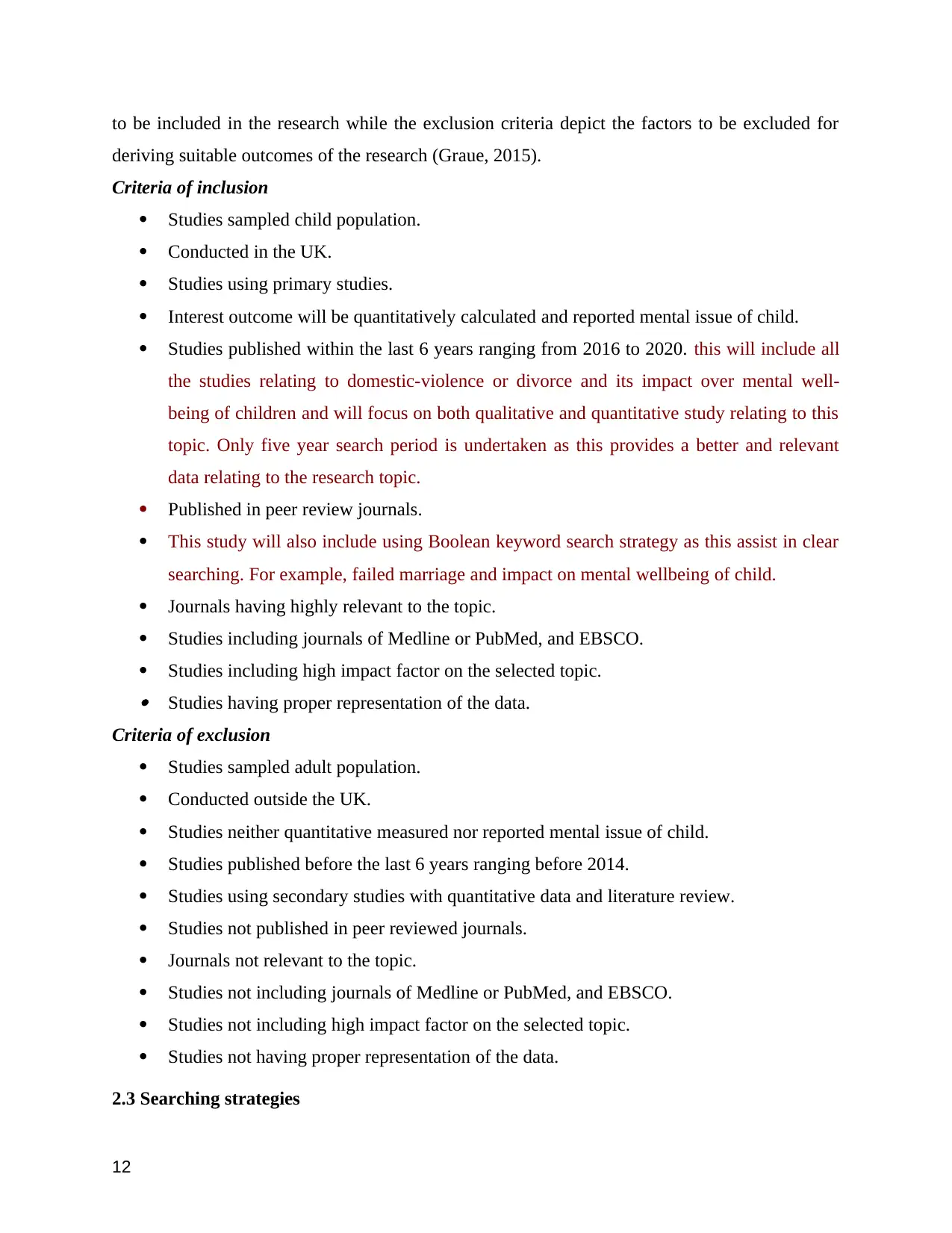
to be included in the research while the exclusion criteria depict the factors to be excluded for
deriving suitable outcomes of the research (Graue, 2015).
Criteria of inclusion
Studies sampled child population.
Conducted in the UK.
Studies using primary studies.
Interest outcome will be quantitatively calculated and reported mental issue of child.
Studies published within the last 6 years ranging from 2016 to 2020. this will include all
the studies relating to domestic-violence or divorce and its impact over mental well-
being of children and will focus on both qualitative and quantitative study relating to this
topic. Only five year search period is undertaken as this provides a better and relevant
data relating to the research topic.
Published in peer review journals.
This study will also include using Boolean keyword search strategy as this assist in clear
searching. For example, failed marriage and impact on mental wellbeing of child.
Journals having highly relevant to the topic.
Studies including journals of Medline or PubMed, and EBSCO.
Studies including high impact factor on the selected topic. Studies having proper representation of the data.
Criteria of exclusion
Studies sampled adult population.
Conducted outside the UK.
Studies neither quantitative measured nor reported mental issue of child.
Studies published before the last 6 years ranging before 2014.
Studies using secondary studies with quantitative data and literature review.
Studies not published in peer reviewed journals.
Journals not relevant to the topic.
Studies not including journals of Medline or PubMed, and EBSCO.
Studies not including high impact factor on the selected topic.
Studies not having proper representation of the data.
2.3 Searching strategies
12
deriving suitable outcomes of the research (Graue, 2015).
Criteria of inclusion
Studies sampled child population.
Conducted in the UK.
Studies using primary studies.
Interest outcome will be quantitatively calculated and reported mental issue of child.
Studies published within the last 6 years ranging from 2016 to 2020. this will include all
the studies relating to domestic-violence or divorce and its impact over mental well-
being of children and will focus on both qualitative and quantitative study relating to this
topic. Only five year search period is undertaken as this provides a better and relevant
data relating to the research topic.
Published in peer review journals.
This study will also include using Boolean keyword search strategy as this assist in clear
searching. For example, failed marriage and impact on mental wellbeing of child.
Journals having highly relevant to the topic.
Studies including journals of Medline or PubMed, and EBSCO.
Studies including high impact factor on the selected topic. Studies having proper representation of the data.
Criteria of exclusion
Studies sampled adult population.
Conducted outside the UK.
Studies neither quantitative measured nor reported mental issue of child.
Studies published before the last 6 years ranging before 2014.
Studies using secondary studies with quantitative data and literature review.
Studies not published in peer reviewed journals.
Journals not relevant to the topic.
Studies not including journals of Medline or PubMed, and EBSCO.
Studies not including high impact factor on the selected topic.
Studies not having proper representation of the data.
2.3 Searching strategies
12
⊘ This is a preview!⊘
Do you want full access?
Subscribe today to unlock all pages.

Trusted by 1+ million students worldwide
1 out of 24
Related Documents
Your All-in-One AI-Powered Toolkit for Academic Success.
+13062052269
info@desklib.com
Available 24*7 on WhatsApp / Email
![[object Object]](/_next/static/media/star-bottom.7253800d.svg)
Unlock your academic potential
Copyright © 2020–2025 A2Z Services. All Rights Reserved. Developed and managed by ZUCOL.





